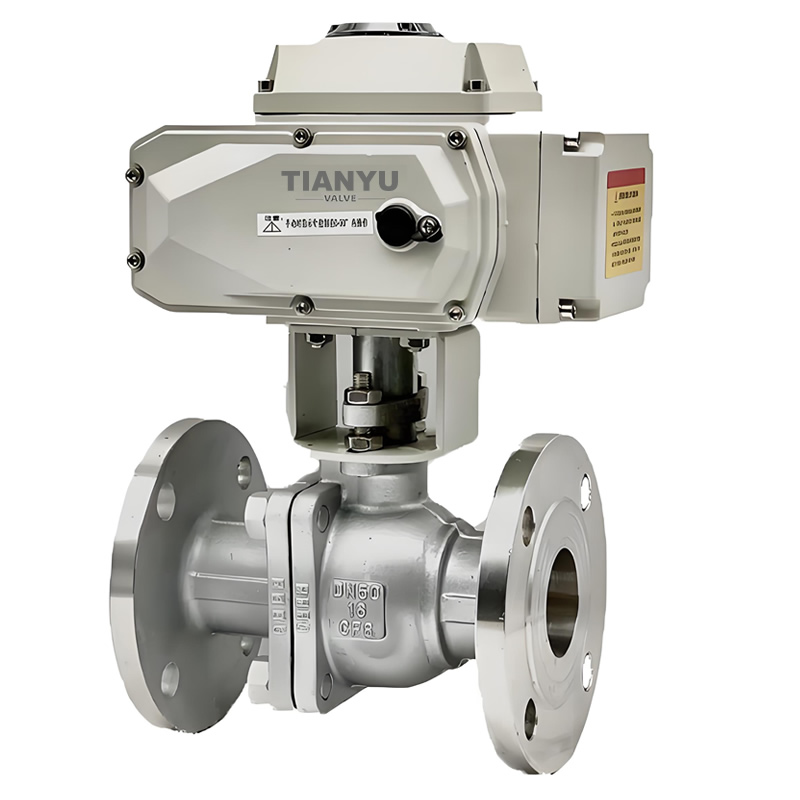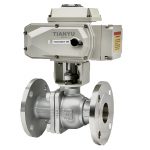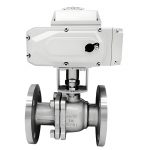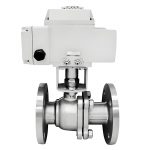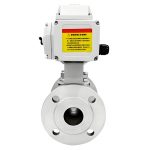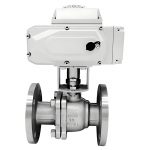TIANYU Stainless Steel Floating Ball Valve: Full Port 2PC Flange-Connected Valve with Fire-Safe & Anti-Static Design for Oil, Gas, and Industrial Media Control
I. Product Overview
II. Key Attribute Specifications
A. Dimensional & Pressure-Temperature Parameters
- Port Size: Ranging from ½” to 8” (DN15 to DN200), covering small to medium-scale industrial pipeline requirements. The full port design ensures the valve’s internal diameter matches the pipeline, minimizing pressure drop and maximizing flow efficiency for applications requiring high throughput.
- Pressure Rating: Class 150 to Class 600 (PN16 to PN100), accommodating low to high-pressure operating conditions. This versatility makes it suitable for both general industrial use and critical high-pressure systems like oil and gas transmission lines.
- Temperature Range: -20℃ to 200℃ (extendable to -40℃ with low-temperature materials), enabled by compatible seat materials (PTFE, RPTFE, PPL, PEEK) and stainless steel’s thermal stability. The range supports cryogenic fluids, ambient media, and moderately heated industrial processes.
B. Material Composition
- Valve Body & Bonnet: Stainless steel (CF8/CF8M/A351, equivalent to 304/316 stainless steel) as standard, with optional WCB carbon steel or low-temperature alloys (LCB/LCC) for specialized applications. CF8M (316 stainless steel) offers superior corrosion resistance to chlorides, acids, and alkalis, ideal for coastal or chemical-rich environments.
- Ball: Solid stainless steel (matching body material) with precision-ground surface finish, ensuring uniform contact with the seat for reliable sealing. The ball’s floating design allows it to shift under media pressure, enhancing seal tightness.
- Valve Stem: 304/316 stainless steel or 17-4PH alloy, featuring an anti-blowout design to prevent stem ejection under pressure. The material resists corrosion and mechanical wear, ensuring long-term operational safety.
- Seat/Seal Materials: PTFE (polytetrafluoroethylene) for general industrial media, RPTFE (reinforced PTFE) for enhanced durability, PPL (poly-phenylene sulfide) for high-temperature applications, and PEEK (polyether ether ketone) for extreme pressure and chemical resistance.
- Gaskets & Packing: Metal gaskets for body-bonnet sealing, preventing leakage due to vibration or temperature fluctuations. PTFE-impregnated packing ensures stem sealing integrity while reducing friction during operation.
C. Connection & Operational Features
- Connection Type: Flange ends (RF/RTJ/BW) conforming to ASME B16.5/ASME B16.47 standards. The RF (Raised Face) flange is suitable for general applications, while RTJ (Ring Type Joint) flanges provide enhanced sealing for high-pressure/high-temperature systems.
- Operation Mode: Manual (hand wheel/worm wheel) as standard, with optional pneumatic or electric actuation for automated control. Worm wheel operators reduce torque requirements for larger valves, enabling easy manual operation, while actuators support remote monitoring and integration with SCADA/DCS systems.
- Safety Features: Optional fire-safe design and anti-static protection. The fire-safe structure ensures metal-to-metal sealing between the ball and body if non-metallic seats burn in a fire, preventing catastrophic media leakage. Anti-static devices discharge static electricity, mitigating explosion risks in flammable media applications.
D. Certifications & Compliance
- Industry Standards: API 608, API 6D, ASME B16.34, ASME B16.10, BS 5351.
- Material Certifications: ASTM A351 (stainless steel), ASTM A216 (WCB), ISO 9001.
- Regional Approvals: CE, ATEX (for hazardous environments), FDA (optional for food-grade applications).
III. Feature Description
A. Floating Ball Design: Self-Enhancing Sealing Performance
B. Full Port Configuration: Maximizing Flow Efficiency
C. Two-Piece (2PC) Body Construction: Durability & Maintenance Ease
D. Fire-Safe & Anti-Static Features: Safety in Hazardous Environments
E. Corrosion-Resistant Stainless Steel Construction

IV. Manufacturing Processes
A. Material Inspection & Preparation
- Raw Material Verification: Stainless steel billets (CF8/CF8M) undergo spectral analysis to confirm chemical composition (Cr: 16–18%, Ni: 10–12%, Mo: 2–3% for CF8M) and ultrasonic testing to detect internal defects. Mechanical testing (tensile, impact) ensures compliance with ASTM A351 standards.
- Seat Material Testing: Seat materials (PTFE, RPTFE, PPL, PEEK) are tested for compression set, tensile strength, and chemical resistance to ensure compatibility with intended media and temperature ranges.
B. Valve Body & Bonnet Fabrication
- Casting: Body and bonnet are produced via investment casting for stainless steel, ensuring dimensional accuracy and a smooth internal surface. Castings are solution-annealed to restore corrosion resistance and relieve internal stresses.
- Machining: CNC turning and milling centers precision-machine the body, bonnet, and flange faces. Flange dimensions are machined to ASME B16.5 standards, with flatness tolerance ≤0.05mm/m and surface finish Ra ≤3.2μm for proper gasket seating. The body’s internal seat pocket is machined to exact tolerances to ensure uniform seat contact.
C. Ball & Stem Manufacturing
- Ball Production: Solid stainless steel blanks are turned, ground, and lapped to achieve a mirror-like surface finish (Ra ≤0.2μm), critical for sealing performance. The ball’s diameter is precision-controlled to ensure a tight fit within the seat.
- Stem Machining: Valve stems are CNC-machined from 316 stainless steel or 17-4PH alloy, with a surface treatment (polishing) to reduce friction and enhance corrosion resistance. The anti-blowout feature is integrated during machining, ensuring the stem cannot be ejected under pressure.
D. Assembly & Quality Testing
- Component Assembly: The ball, stem, seat, and packing are assembled into the body-bonnet assembly. The seat is press-fitted into the body pocket, with spring loading to compensate for thermal expansion and wear. The bonnet is secured with studs and nuts, with the gasket compressed to form a leak-tight seal.
- Hydrostatic Testing: The valve undergoes shell testing at 1.5× rated pressure and seat testing at 1.1× rated pressure, with no leakage allowed. For gas service, pneumatic testing is performed to confirm bubble-tight sealing.
- Operational & Safety Testing: The valve is cycled 100 times to verify smooth operation and torque consistency. Fire-safe testing (per API 607) and anti-static testing are conducted for valves with these features, ensuring compliance with safety standards.
- Traceability & Documentation: Each valve is marked with a unique serial number for material traceability. Test reports, material certificates, and compliance documents (API 608/API 6D) are provided with every unit.
V. Product Advantages
A. Superior Sealing Reliability
B. Flow Efficiency & Energy Savings
C. Durability in Harsh Environments
D. Safety Compliance for Hazardous Applications
E. Versatile Installation & Maintenance
F. Broad Application Compatibility
VI. Product Applications
A. Oil & Gas Industry
- Upstream Exploration: Controls flow of crude oil, natural gas, and drilling fluids in wellheads and production lines. The fire-safe and anti-static features are critical for offshore and onshore drilling platforms.
- Midstream Transmission: Regulates flow in pipelines transporting crude oil, refined products, or natural gas. The high-pressure rating (Class 600) and corrosion resistance make it suitable for long-distance transmission lines.
- Downstream Refining: Manages flow of hydrocarbons, solvents, and steam in refinery units. The full port design supports high flow rates in gasoline blending and distillation systems.
B. Chemical Processing
- Acid/Alkali Handling: Controls flow of sulfuric acid, hydrochloric acid, sodium hydroxide, and other corrosive chemicals. CF8M stainless steel and PTFE/PEEK seats ensure chemical inertness and long-term reliability.
- Solvent & Petrochemical Processing: Regulates flow of organic solvents, monomers, and petrochemical intermediates. The fire-safe design minimizes risks in flammable solvent applications.
C. Water & Wastewater Treatment
- Desalination Plants: Handles seawater and brine in reverse osmosis systems. CF8M stainless steel resists chloride-induced corrosion, ensuring durability in coastal environments.
- Industrial Wastewater: Manages flow of corrosive effluents in manufacturing facilities. The robust construction withstands abrasive solids and chemical-rich wastewater.
D. Power Generation
- Thermal Power Plants: Controls flow of steam, cooling water, and lubricating oils in boilers, turbines, and auxiliary systems. The high-temperature tolerance (up to 200℃) supports continuous operation.
- Nuclear Power Auxiliaries: Regulates flow of cooling water and process fluids in non-radiation zones. Stainless steel construction ensures compliance with strict safety and corrosion standards.
E. General Industrial Applications
- Pharmaceutical Manufacturing: With FDA-compliant PTFE seats, the valve handles sanitized process fluids and APIs (Active Pharmaceutical Ingredients) in sterile environments.
- Food & Beverage: Controls flow of food-grade media (juices, dairy, beverages) with non-toxic seals, ensuring product purity.
- Marine & Offshore: Manages seawater, fuel, and hydraulic fluids in ships and offshore platforms. Corrosion-resistant materials withstand saltwater exposure and harsh marine conditions.
VII. Summary & Customization
RELATED
-

High Temperature/Pressure 304 Stainless Steel Resistant Manual Power Forged Three Piece Flanged Floating Ball Valve
TIANYU 304 Stainless Steel Flanged Floating Ball Valve: Corrosion-Resistant Full-Port Flow Control Solution for Industrial, Sanitary, and Municipal Me…
BALL VALVE 11/03/2025 -

API ANSI 2in-16in DN50-DN400 PN10 PN16 CF8M Pneumatic Flanged Floating Ball Valve
TIANYU CF8M Pneumatic Flanged Floating Ball Valve: 2in-16in (DN50-DN400) PN10-PN16 API/ANSI Class Corrosion-Resistant Flow Control Solution for Indust…
BALL VALVE 11/01/2025 -

Large-Diameter DN1400 CLASS150 WCB SS Triple Eccentric Metal-Sealed Hard Seal Butterfly Valve
TIANYU DN1400 (56″) CLASS 150 WCB Hard Seal Butterfly Valve: Triple Eccentric Metal-Sealed Flanged Valve for Large-Diameter Industrial Media wit…
BUTTERFLY VALVE 10/30/2025 -

High-Performance DN80 Class 150 WCB Soft-Sealed Lug-Type Double Eccentric Butterfly Valve
TIANYU 3” Class 150 WCB lug-type double eccentric butterfly valve is a technologically advanced flow control device engineered to address the challeng…
BUTTERFLY VALVE 10/25/2025 -

DN125 PN16 CF8M Stainless Steel Lug-Type Butterfly Valve with PTFE Lining Concentric Line Butterfly Valves
TIANYU DN125 PN16 CF8M stainless steel lug-type butterfly valve is a precision-engineered flow control device designed to address the challenges of ha…
BUTTERFLY VALVE 10/25/2025 -

API6D ASME DN100 PN16 CF8/316L stainless steel Electric Actuator Motorized Floating Ball Valve For Normal Temperature Water
TIANYU DN100 PN16 CF8 Electric Actuator Motorized Ball Valve: Stainless Steel Flanged Full-Port Flow Control Solution for Industrial Media with Automa…
BALL VALVE 10/24/2025


